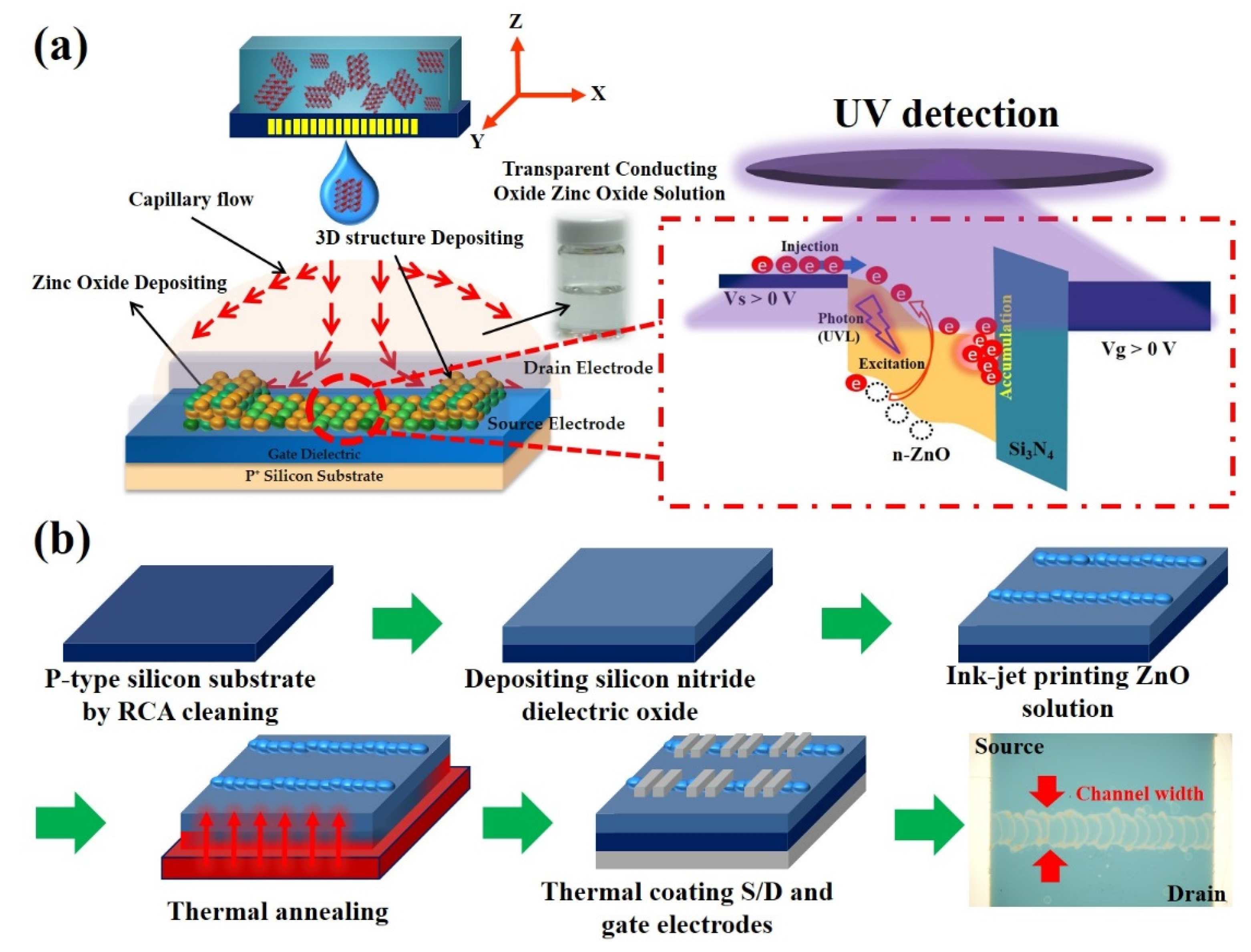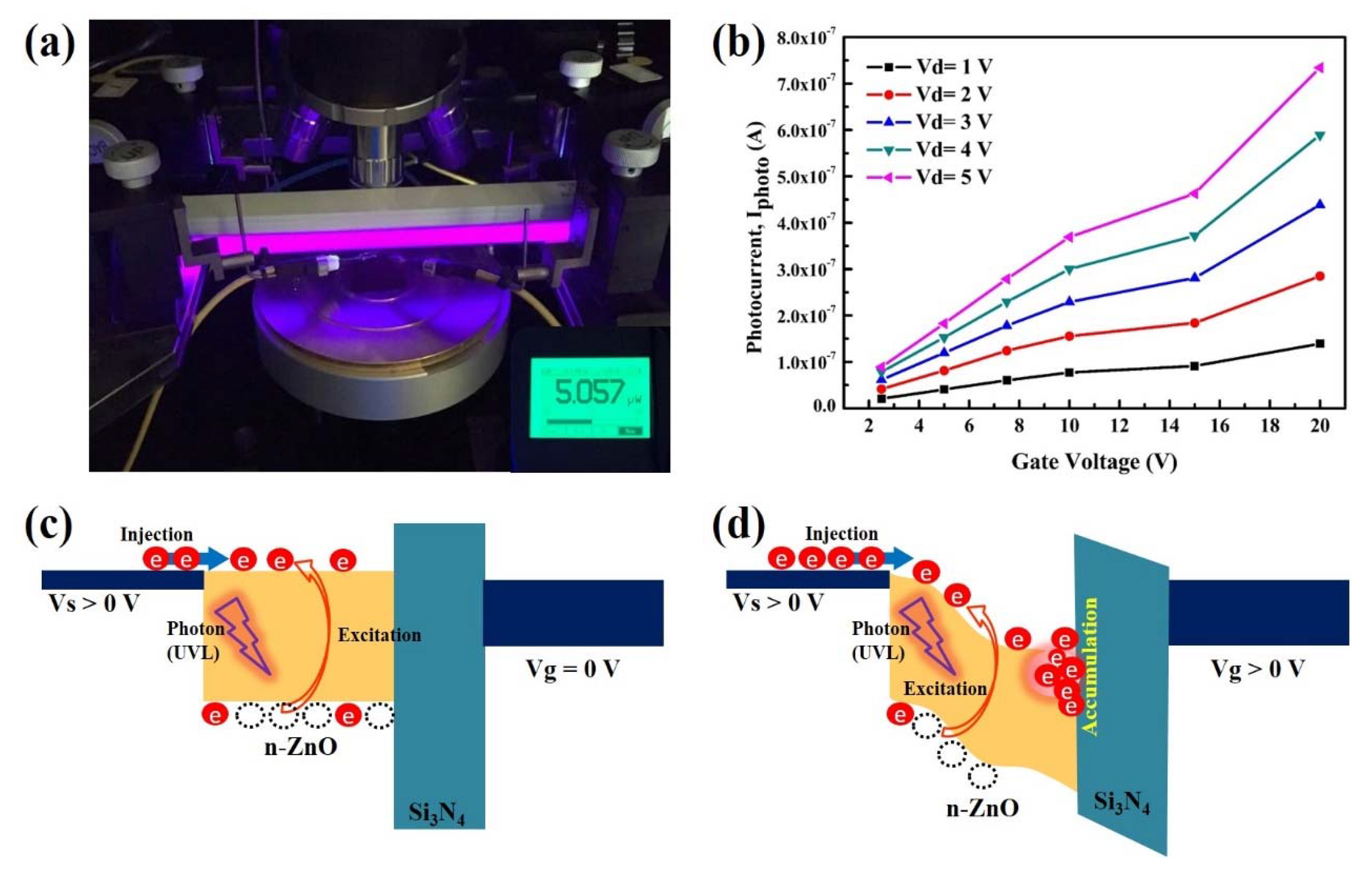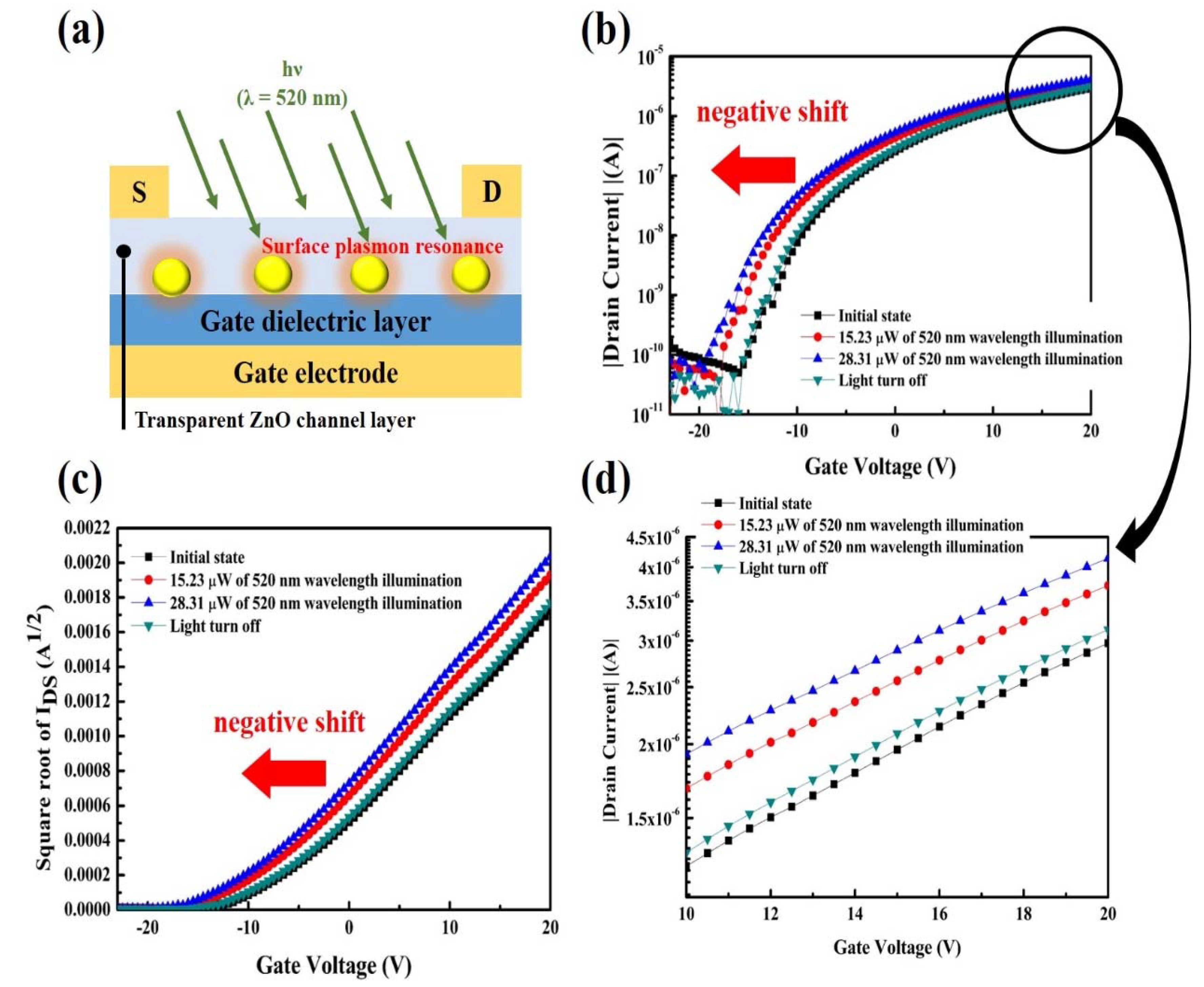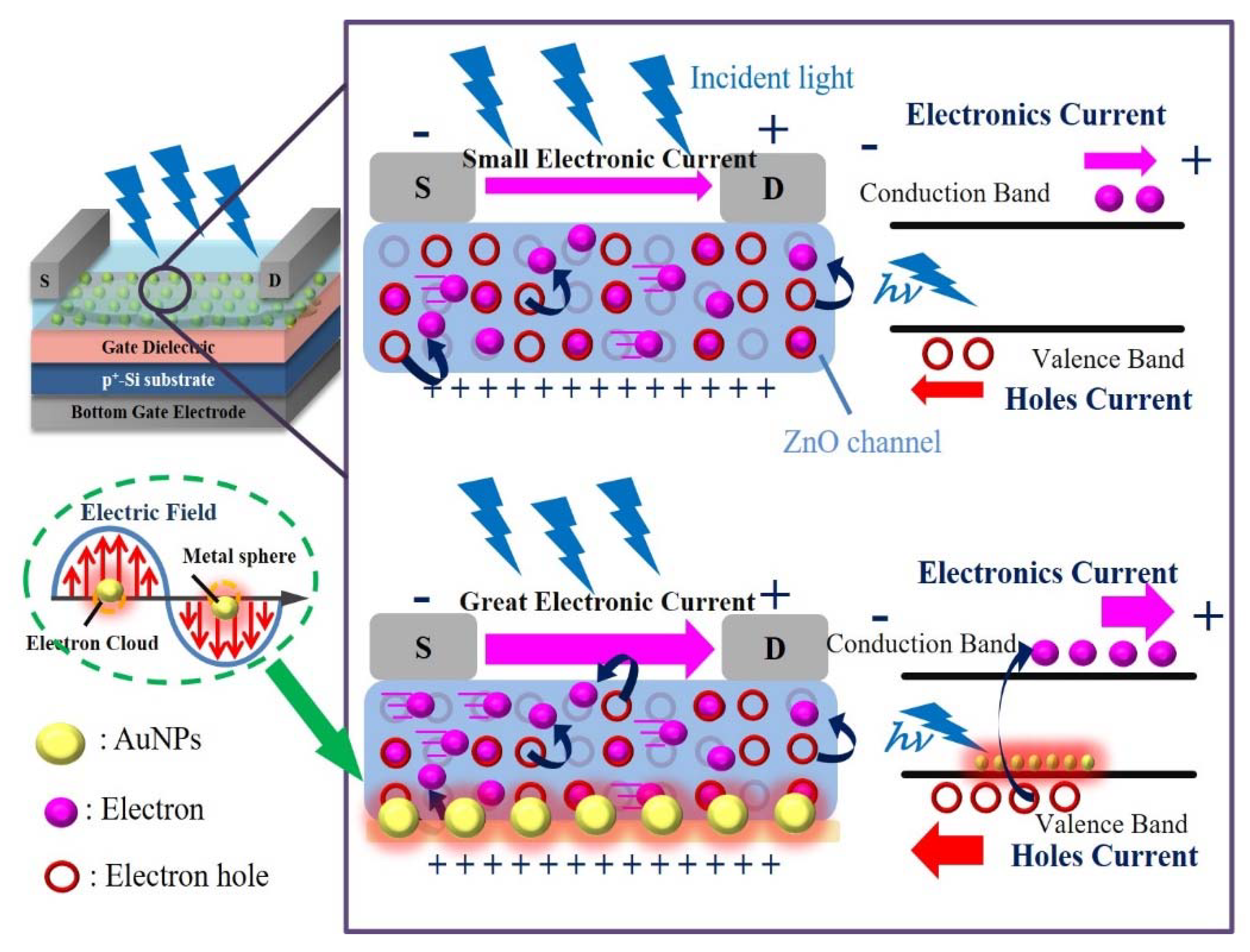Ultraviolet Photodetecting and Plasmon-to-Electric Conversion of Controlled Inkjet-Printing Thin-Film Transistors
Abstract
:1. Introduction
2. Materials and Methods
2.1. The Semiconducting Material of Zinc-Oxide Solution
2.2. The Device Fabrication
3. Results and Discussions
3.1. Coffee-Ring Structure of 3-D Narrow Channel Formation
3.2. Electrical Characterization
3.3. ZnO-based Thin-Film Transistor (TFT) of Ultraviolet (UV) and Visible Light Photodetector Performance Characterization
3.4. Plasmon TFTs of ZnO-Based Visible Light Photodetector Performance Characterization
4. Conclusions
Supplementary Materials
Author Contributions
Funding
Conflicts of Interest
References
- Vegiraju, S.; Chang, B.C.; Priyanka, P.; Huang, D.Y.; Wu, K.Y.; Li, L.H.; Chang, W.C.; Lai, Y.Y.; Hong, S.H.; Yu, B.C.; et al. Intramolecular Locked Dithioalkylbithiophene-Based Semiconductors for High-Performance Organic Field-Effect Transistors. Adv. Mater. 2017, 29, 1702414. [Google Scholar] [CrossRef] [PubMed]
- Zhao, Q.; Wang, H.; Ni, Z.; Liu, J.; Zhen, Y.; Zhang, X.; Jiang, L.; Li, R.; Dong, H.; Hu, W. Organic Ferroelectric-Based 1T1T Random Access Memory Cell Employing a Common Dielectric Layer Overcoming the Half-Selection Problem. Adv. Mater. 2017, 29, 1701907. [Google Scholar] [CrossRef] [PubMed]
- Chen, Z.; Zhang, W.; Huang, J.; Gao, D.; Wei, C.; Lin, Z.; Wang, L.; Yu, G. Fluorinated Dithienylethene-Naphthalenediimide Copolymers for High-Mobility n-Channel Field-Effect Transistors. Macromolecules 2017, 50, 6098–6107. [Google Scholar] [CrossRef]
- Kim, D.; Kim, Y.; Lee, S.; Kang, M.S. High Resolution a-IGZO TFT Pixel Circuit for Compensating Threshold Voltage Shifts and OLED Degradations. IEEE J. Electron. Devices Soc. 2017, 5, 372–377. [Google Scholar] [CrossRef]
- Yang, Y.; Rice, B.; Shi, X.; Brandt, J.R.; Correa Da Costa, R.; Hedley, G.J.; Smilgies, D.M.; Frost, J.M.; Samuel, I.D.W.; Otero-De-La-Roza, A.; et al. Emergent Properties of an Organic Semiconductor Driven by its Molecular Chirality. ACS Nano 2017, 11, 8329–8338. [Google Scholar] [CrossRef] [Green Version]
- Moreira, M.; Carlos, E.; Dias, C.; Deuermeier, J.; Pereira, M.; Barquinha, P.; Branquinho, R.; Martins, R.; Fortunato, E. Tailoring IGZO composition for enhanced fully solution-based thin film transistors. Nanomaterials 2019, 9, 1273. [Google Scholar] [CrossRef] [Green Version]
- You, H.C.; Wang, C.J. Low-Temperature, Solution-Processed, Transparent Zinc Oxide-based Thin-Film Transistors for Sensing Various Solvents. Materials 2017, 10, 234. [Google Scholar] [CrossRef] [Green Version]
- Li, Y.; Lan, L.; Sun, S.; Lin, Z.; Gao, P.; Song, W.; Song, E.; Zhang, P.; Peng, J. All Inkjet-Printed Metal-Oxide Thin-Film Transistor Array with Good Stability and Uniformity Using Surface-Energy Patterns. ACS Appl. Mater. Interfaces 2017, 9, 8194–8200. [Google Scholar] [CrossRef]
- Banger, K.K.; Yamashita, Y.; Mori, K.; Peterson, R.L.; Leedham, T.; Rickard, J.; Sirringhaus, H. Low-Temperature, High-Performance Solution-Processed Metal Oxide Thin-Film Transistors Formed by a ‘Sol–Gel on Chip’ Process. Nat. Mater. 2011, 10, 45–50. [Google Scholar] [CrossRef]
- Tortorich, R.; Choi, J.-W. Inkjet Printing of Carbon Nanotubes. Nanomaterials 2013, 3, 453–468. [Google Scholar] [CrossRef] [Green Version]
- Lin, F.J.; Guo, C.; Chuang, W.T.; Wang, C.L.; Wang, Q.; Liu, H.; Hsu, C.S.; Jiang, L. Directional Solution Coating by the Chinese Brush: A Facile Approach to Improving Molecular Alignment for High-Performance Polymer TFTs. Adv. Mater. 2017, 29, 1606987. [Google Scholar] [CrossRef] [PubMed]
- Kell, A.J.; Paquet, C.; Mozenson, O.; Djavani-Tabrizi, I.; Deore, B.; Liu, X.; Lopinski, G.P.; James, R.; Hettak, K.; Shaker, J.; et al. Versatile Molecular Silver Ink Platform for Printed Flexible Electronics. ACS Appl. Mater. Interfaces 2017, 9, 17226–17237. [Google Scholar] [CrossRef] [PubMed] [Green Version]
- Lin, Y.; Liu, C.F.; Song, Y.; Yang, L.; Zeng, W.; Lai, W.Y.; Huang, W. Improved Performances of Inkjet-Printed Poly(3-hexylthiophene) Organic Thin-Film Transistors by Inserting an Ionic Self-Assembled Monolayer. RSC Adv. 2016, 6, 40970–40974. [Google Scholar] [CrossRef]
- Singh, M.; Haverinen, H.M.; Dhagat, P.; Jabbour, G.E. Inkjet Printing-Process and Its Applications. Adv. Mater. 2010, 22, 673–685. [Google Scholar] [CrossRef]
- Hwang, J.K.; Cho, S.; Dang, J.M.; Kwak, E.B.; Song, K.; Moon, J.; Sung, M.M. Direct Nanoprinting by Liquid-Bridge-Mediated Nanotransfer Moulding. Nat. Nanotechnol. 2010, 5, 742–748. [Google Scholar] [CrossRef]
- Kuang, M.; Wang, L.; Song, Y. Controllable Printing Droplets for High-Resolution Patterns. Adv. Mater. 2014, 26, 6950–6958. [Google Scholar] [CrossRef]
- Cui, L.; Zhang, J.; Zhang, X.; Huang, L.; Wang, Z.; Li, Y.; Gao, H.; Zhu, S.; Wang, T.; Yang, B. Suppression of the Coffee Ring Effect by Hydrosoluble Polymer Additives. ACS Appl. Mater. Interfaces 2012, 4, 2775–2780. [Google Scholar] [CrossRef]
- Nguyen, T.A.H.; Hampton, M.A.; Nguyen, A.V. Evaporation of Nanoparticle Droplets on Smooth Hydrophobic Surfaces: The Inner Coffee Ring Deposits. J. Phys. Chem. C 2013, 117, 4707–4716. [Google Scholar] [CrossRef]
- Shen, X.; Ho, C.M.; Wong, T.S. Minimal Size of Coffee Ring Structure. J. Phys. Chem. B 2010, 114, 5269–5274. [Google Scholar] [CrossRef] [Green Version]
- Eom, D.S.; Chang, J.; Song, Y.W.; Lim, J.A.; Han, J.T.; Kim, H.; Cho, K. Coffee-Ring Structure from Dried Graphene Derivative Solutions: A Facile One-Step Fabrication Route for All Graphene-Based Transistors. J. Phys. Chem. C 2014, 118, 27081–27090. [Google Scholar] [CrossRef]
- Zhang, Z.; Zhang, X.; Xin, Z.; Deng, M.; Wen, Y.; Song, Y. Controlled Inkjetting of a Conductive Pattern of Silver Nanoparticles Based on the Coffee-Ring Effect. Adv. Mater. 2013, 25, 6714–6718. [Google Scholar] [CrossRef] [PubMed]
- Li, Y.; Lan, L.; Xiao, P.; Sun, S.; Lin, Z.; Song, W.; Song, E.; Gao, P.; Wu, W.; Peng, J. Coffee-Ring Defined Short Channels for Inkjet-Printed Metal Oxide Thin-Film Transistors. ACS Appl. Mater. Interfaces 2016, 8, 19643–19648. [Google Scholar] [CrossRef] [PubMed]
- Khan, F.; Khan, W.; Kim, S.D. High-performance ultraviolet light detection using nano-scale-fin isolation AlGaN/GaN heterostructures with ZnO nanorods. Nanomaterials 2019, 9, 440. [Google Scholar] [CrossRef] [PubMed] [Green Version]
- Ajmal, H.M.S.; Khan, F.; Ul Huda, N.; Lee, S.; Nam, K.; Kim, H.Y.; Eom, T.H.; Kim, S.D. High-performance flexible ultraviolet photodetectors with Ni/Cu-codoped ZnO nanorods grown on PET substrates. Nanomaterials 2019, 9, 1067. [Google Scholar] [CrossRef] [PubMed] [Green Version]
- Son, Y.; Li, J.; Peterson, R.L. In Situ Chemical Modification of Schottky Barrier in Solution-Processed Zinc Tin Oxide Diode. ACS Appl. Mater. Interfaces 2016, 8, 23801–23809. [Google Scholar] [CrossRef]
- Yun, M.G.; Kim, Y.K.; Ahn, C.H.; Cho, S.W.; Kang, W.J.; Cho, H.K.; Kim, Y.H. Low voltage-driven oxide phototransistors with fast recovery, high signal-to-noise ratio, and high responsivity fabricated via a simple defect-generating process. Sci. Rep. 2016, 6, 31991. [Google Scholar] [CrossRef]
- Ahn, C.H.; Kang, W.J.; Kim, Y.K.; Yun, M.G.; Cho, H.K. Highly Repeatable and Recoverable Phototransistors Based on Multifunctional Channels of Photoactive CdS, Fast Charge Transporting ZnO, and Chemically Durable Al2O3 Layers. ACS Appl. Mater. Interfaces 2016, 8, 15518–15523. [Google Scholar] [CrossRef]
- Ye, D.; Mei, Z.; Liang, H.; Zhang, Y.; Li, J.; Liu, Y. A three-terminal ultraviolet photodetector constructed on a barrier-modulated triple-layer architecture. Sci. Rep. 2016, 6, 26169. [Google Scholar] [CrossRef] [Green Version]
- Wu, Z.Q.; Yang, J.L.; Manjunath, N.K.; Zhang, Y.J.; Feng, S.R.; Lu, Y.H.; Wu, J.H.; Zhao, W.W.; Qiu, C.Y.; Li, J.F.; et al. Gap-Mode Surface-Plasmon-Enhanced Photoluminescence and Photoresponse of MoS2. Adv. Mater. 2018, 30, e1706527. [Google Scholar] [CrossRef]
- Shin, S.W.; Lee, K.H.; Park, J.S.; Kang, S.J. Highly Transparent, Visible-Light Photodetector Based on Oxide Semiconductors and Quantum Dots. ACS Appl. Mater. Interfaces 2015, 7, 19666–19671. [Google Scholar] [CrossRef]
- Shokri Kojori, H.; Yun, J.H.; Paik, Y.; Kim, J.; Anderson, W.A.; Kim, S.J. Plasmon Field Effect Transistor for Plasmon to Electric Conversion and Amplification. Nano Lett. 2016, 16, 250–254. [Google Scholar] [CrossRef] [PubMed]
- Kim, H.; Jang, J.I.; Kim, H.H.; Lee, G.W.; Lim, J.A.; Han, J.T.; Cho, K. Sheet Size-Induced Evaporation Behaviors of Inkjet-Printed Graphene Oxide for Printed Electronics. ACS Appl. Mater. Interfaces 2016, 8, 3193–3199. [Google Scholar] [CrossRef] [PubMed]
- Lovass, P.; Branicki, M.; Tóth, R.; Braun, A.; Suzuno, K.; Ueyama, D.; Lagzi, I. Maze Solving Using Temperature-Induced Marangoni Flow. RSC Adv. 2015, 5, 48563–48568. [Google Scholar] [CrossRef] [Green Version]
- Khan, W.; Ajmal, H.M.S.; Khan, F.; Ul Huda, N.; Kim, S.D. Induced photonic response of ZnO nanorods grown on oxygen plasma-treated seed crystallites. Nanomaterials 2018. [Google Scholar] [CrossRef] [Green Version]
- Lin, Y.H.; Lee, C.T. Stability of Indium Gallium Zinc Aluminum Oxide Thin-Film Transistors with Treatment Processes. J. Electron. Mater. 2017, 46, 936–940. [Google Scholar] [CrossRef]
- Kaftelen, H.; Ocakoglu, K.; Thomann, R.; Tu, S.; Weber, S.; Erdem, E. EPR and Photoluminescence Spectroscopy Studies on the Defect Structure of ZnO Nanocrystals. Phys. Rev. B 2012, 86, 014113. [Google Scholar] [CrossRef]
- Meena, J.S.; Chu, M.-C.; Chang, Y.-C.; You, H.-C.; Singh, R.; Liu, P.-T.; Shieh, H.-P.D.; Chang, F.-C.; Ko, F.-H. Effect of Oxygen Plasma on the Surface States of ZnO Films Used to Produce Thin-Film Transistors on Soft Plastic Sheets. J. Mater. Chem. C 2013, 1, 6613–6622. [Google Scholar] [CrossRef]
- Le, A.H.T.; Kim, Y.; Lee, Y.J.; Hussain, S.Q.; Nguyen, C.P.T.; Lee, J.; Yi, J. On the Origin of the Changes in the Opto-Electrical Properties of Boron-Doped Zinc Oxide Films after Plasma Surface Treatment for Thin-Film Silicon Solar Cell Applications. Appl. Surf. Sci. 2018, 433, 798–805. [Google Scholar] [CrossRef]
- Liu, Q.; Gong, M.; Cook, B.; Thapa, P.; Ewing, D.; Casper, M.; Stramel, A.; Wu, J. Oxygen Plasma Surface Activation of Electron-Depleted ZnO Nanoparticle Films for Performance-Enhanced Ultraviolet Photodetectors. Phys. Status Solidi A-Appl. Mater. 2017, 214, 1700176. [Google Scholar] [CrossRef]
- Liu, X.; Gu, L.; Zhang, Q.; Wu, J.; Long, Y.; Fan, Z. All-Printable Band-Edge Modulated ZnO Nanowire Photodetectors with Ultra-High Detectivity. Nat. Commun. 2014, 5, 4007. [Google Scholar] [CrossRef] [Green Version]
- Gong, M.; Liu, Q.; Cook, B.; Kattel, B.; Wang, T.; Chan, W.L.; Ewing, D.; Casper, M.; Stramel, A.; Wu, J.Z. All-Printable ZnO Quantum Dots/Graphene van der Waals Heterostructures for Ultrasensitive Detection of Ultraviolet Light. ACS Nano 2017, 11, 4114–4123. [Google Scholar] [CrossRef] [PubMed]








© 2020 by the authors. Licensee MDPI, Basel, Switzerland. This article is an open access article distributed under the terms and conditions of the Creative Commons Attribution (CC BY) license (http://creativecommons.org/licenses/by/4.0/).
Share and Cite
Wang, C.-J.; You, H.-C.; Ou, J.-H.; Chu, Y.-Y.; Ko, F.-H. Ultraviolet Photodetecting and Plasmon-to-Electric Conversion of Controlled Inkjet-Printing Thin-Film Transistors. Nanomaterials 2020, 10, 458. https://doi.org/10.3390/nano10030458
Wang C-J, You H-C, Ou J-H, Chu Y-Y, Ko F-H. Ultraviolet Photodetecting and Plasmon-to-Electric Conversion of Controlled Inkjet-Printing Thin-Film Transistors. Nanomaterials. 2020; 10(3):458. https://doi.org/10.3390/nano10030458
Chicago/Turabian StyleWang, Cheng-Jyun, Hsin-Chiang You, Jen-Hung Ou, Yun-Yi Chu, and Fu-Hsiang Ko. 2020. "Ultraviolet Photodetecting and Plasmon-to-Electric Conversion of Controlled Inkjet-Printing Thin-Film Transistors" Nanomaterials 10, no. 3: 458. https://doi.org/10.3390/nano10030458




